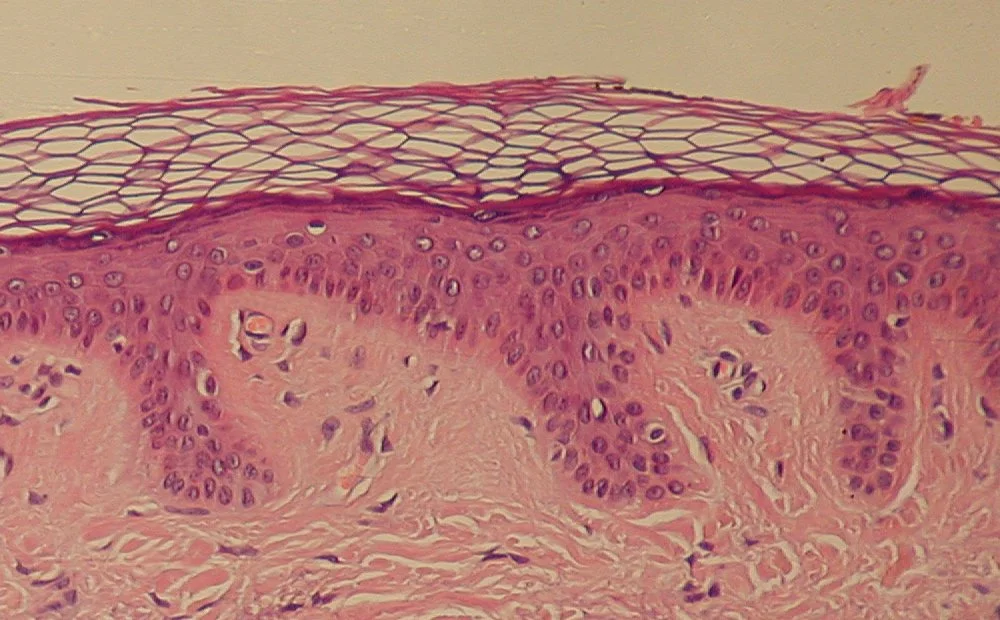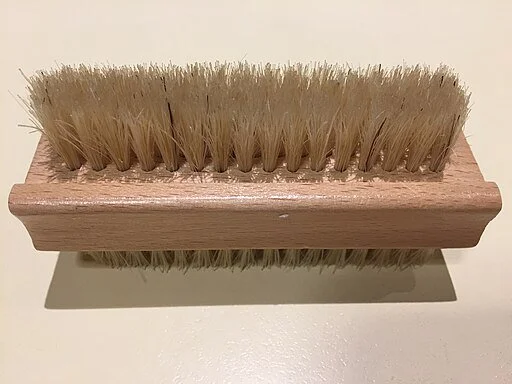https://commons.wikimedia.org/wiki/File:Shaving_brush_(1962321260).jpg, Marco Arment from New York, NY, USA, CC BY 2.0 <https://creativecommons.org/licenses/by/2.0>, via Wikimedia Commons
Deborah Tosline published the book “Skin Remodeling DIY: An Introduction to the Underground World of Do-It-Yourself Skincare” in 2015. Her approach to skincare is based on a scientific background, a love of research, and over 40 years of Do-It-Yourself (DIY) skincare experience.
I can’t pinpoint when and where my desire to develop an integrative healthy lifestyle came to be. I may have been heavily influenced by my love of nature and the natural living counterculture of the 1960’s. I do know that by the age of 17 I recognized that I needed to work hard for the rest of my life. In my twenties, I realized that I did not enjoy work when I didn’t feel well. I made a promise to myself to “do everything in my power to maintain my health” so that I could comfortably work. I’ve followed that doctrine throughout my adult life. And so began my lifelong journey of consistently implementing a variety of self-maintenance practices including dry brushing.
I’ve dry brushed for about 20 years. I initially sought the standard benefits including skin exfoliation, increased circulation, fascia smoothing and enhancing lymphatic flow. I continued because dry brushing is invigorating and makes me feel good.
A stout dry brushing session is refreshing.
Dry brushing is an ancient practice. It is reported to have been practiced in India, China, Ancient Egypt, Rome and many other locations around the world. Dry brushing was used in Ayurvedic medicine 5,000 years ago. Contemporary use of dry brushing was introduced about 30 years ago. Dry brushing has historically been practiced using local materials, such as plant fibers, to scrape the skin.
Dry brushing may be practiced using a variety of tools including towels, gloves, metal scrapers, and soft and firm brushes. The skin is brushed while dry. The dry brushing technique consists of firm sweeping strokes over the skin, starting at each extremity and moving towards the abdomen.
A stiff brush on dry skin increases the exfoliation and circulation of the skin.
There is limited research available regarding the benefits of dry brushing and there are mixed reports regarding the impact of dry brushing on lymphatic stimulation. What to think? There is an abundance of anecdotal evidence showing that over thousands of years multiple societies throughout the world used dry brushing for health. When there is little scientific evidence (and not much motivation to conduct research), the overwhelming anecdotal experience is positive, and my own experience is positive, I continue the practice.
https://commons.wikimedia.org/wiki/File:Normal_Epidermis_and_Dermis_with_Intradermal_Nevus_10x-cropped.JPG, Normal_Epidermis_and_Dermis_with_Intradermal_Nevus_10x.JPG: Kilbadderivative work: Fama Clamosa, Public domain, via Wikimedia Commons
Dry brushing scrapes away old skin cells from the skin’s surface. This practice exposes new skin cells. Exfoliating the skin unclogs pores and enhances normal skin function like sweating and toxin elimination.
Vigorous dry brushing increases skin circulation and may cause the skin to flush. Stimulating skin circulation increases the supply of nutrients and oxygen available for collagen production.
Fascia is an often overlooked yet important soft tissue. Fascia lies beneath the skin and over the organs. It is similar to a head-to-toe elastic suit that keeps our organs and everything else nicely packaged. The fascia is meant to move freely and fluidly. When the fascia becomes twisted and congested it impacts how we physically feel and may restrain movement. When our fascia is not smooth it is apparent, fat cells bulge through the fascia or our body may ache. Brisk dry brushing may superficially calm and smooth fascia. This is anecdotal evidence, but the backs of my old thighs are quite smooth and I attribute this to decades of dry brushing.
Dry brushing may stimulate lymphatic flow. The lymphatic system collects lymph fluid from the blood and organs, filters waste for elimination, and recirculates clean lymph fluid. Lymphatic structures are located throughout the body. Eighty percent of the body’s lymph fluid is produced in the liver and intestine. The lymphatic system does not have a pump. It is stimulated by respiration, muscle movement, and lymphatic vessel contraction. To enhance lymphatic flow it is important that we engage in regular movement and maintain good posture to support proper breathing. When lymphatic fluid cannot flow it may become congested and result in puffiness (think puffy eyes) and discomfort.
https://commons.wikimedia.org/wiki/File:Brush,_vegetable_fibers_-_Museo_Egizio,_Turin_S_7653_p02.jpg, Museo Egizio In Turin (IT), CC0, via Wikimedia Commons
Standard Dry Brushing Technique
Dry brush on dry skin. Begin at the fingertips and brush in one direction sweeping up the arm while continuously brushing towards the shoulder and then towards the abdomen. Start at the toes and dry brush in upward strokes sweeping continuously from the toes towards the abdomen. Brush all skin surfaces. Some skin areas may require a lighter sweep and other areas can tolerate firmer sweeps. DIY dry brushing may be a bit of a workout; it requires strength and flexibility to dry brush yourself.
My dry brushing Experience:
It took a minute for me to acclimate myself to DIY dry brushing. A natural bristle body brush is quite stiff when dry. I began slowly and over time increased the pressure while brushing. After a couple of decades of DIY dry brushing, I’ve become exuberant about the endeavor. I’m a bit fatigued after completing a DIY dry brushing session due to my firm and vigorous sweeps.
A dry brushing routine may be done before a shower or bath. I’ve developed a tendency to add it to my weekly sauna session. It’s become so ingrained that I can’t jump in the sauna without completing a good dry brushing.
My dry brushing routine:
I use a stiff dry brush with a long handle.
I never use my dry brush in water. I only use it in dry conditions.
I dry brush dry skin over the entire skin surface, from far extremities to the abdomen including the webbing between the fingers and toes.
Afterwards I apply a heavy oil or cream to the skin. After reading about this years ago, I’ve followed it ever since. I find it to be soothing. I use organic, cold-pressed oils like castor oil, jojoba, or any oil on hand. I also use a heavy DIY cream that contains anti-inflammatory comfrey and arnica herb oils.
I lay on a towel in the sauna for 20 to 60 minutes. I have done weekly saunas for over 30 years and am acclimated to long treatments. When I first began I saunaed for a maximum of 10 minutes at a time. Today, I may sauna 2 to 4 times for 20-minutes and take cold shower breaks in between sessions.
When I do not have access to a sauna, I complete dry brushing in the shower. I do not apply oil or cream, I simply take a shower or an epsom salt bath.
After all these years of dry brushing, I noticed something new. Recently, my hand accidentally brushed against my thigh skin and it caught my attention, the skin felt silky smooth following a dry brushing / suana session.
https://commons.wikimedia.org/wiki/File:Wooden_nail_brush_with_natural_bristles.jpg, Gill King, CC BY-SA 2.0 <https://creativecommons.org/licenses/by-sa/2.0>, via Wikimedia Commons
Dry brushing caution:
Never dry brush over open wounds, cuts, scrapes, burns, red or irritated skin.
Dry brush skin that is healthy and has good integrity.
Dry brushing compromised skin can cause further damage.
Dry brush a small area to assess the skin’s reaction.
Begin with a softer bristle brush before increasing to a stiff bristle brush.
Try to use natural bristles instead of synthetic bristles to reduce exposure to plastic.
I like this Yerba Prima, natural bristle Tampico Skin Brush for about $17 USD. I am not affiliated with this product. I personally purchased this brush in about 2023 and continue to use it.
Photo: https://yerba.com/product/tampico-skin-brush/?srsltid=AfmBOooaQV6oxJbPOJWjTWKMscAHp6mClHXWBQt8-JLXY28T2WnNyv5_
If you want to wake up your epidermis, slough off old skin cells, enhance skin circulation, show some love to your fascia and possibly stimulate a sluggish lymphatic system, dry brushing may be the DIY self-care gift for you. Your self-care practice enhances your ability to care for and maintain yourself for whatever the future may bring.
If you need more information about DIY skin care, check out the local library, search the Internet, or check out my past Blog articles. It would be an honor for me if you purchased my skin care book. Thank you!
Take good care of yourselves!
XO Deborah
This article is intended to be used as general information only and is in no way intended to replace medical advice, be used as a medical treatment program, diagnosis, or cure of any disease or medical condition. There are no warranties, expressed or implied, regarding the effectiveness of the practices described in this article. Products or substances discussed herein are for educational purposes only and are not intended as recommendations of the author.




